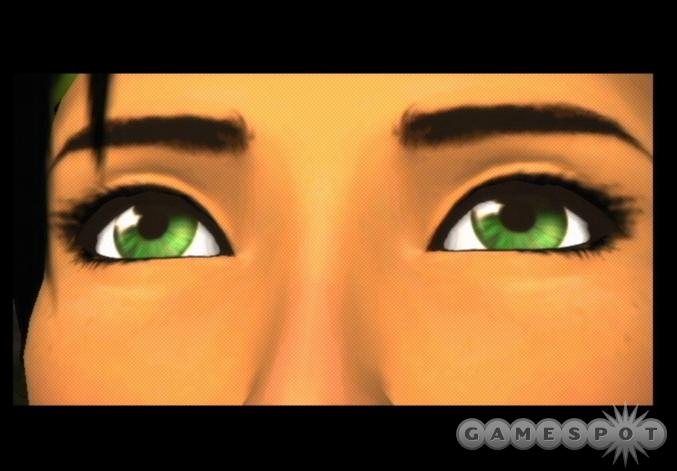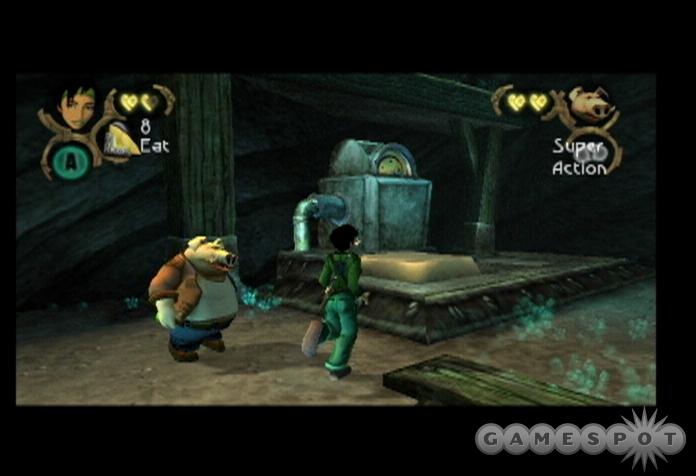Beyond Good & Evil is an action adventure game from Michel Ancel, the man credited with the creation of the highly acclaimed Rayman series. This time out, Ancel is shelving his platform-genre roots in favor of a Legend of Zelda-like game with a heavy focus on puzzle-solving and stealth. While Beyond Good & Evil feels pretty short, its interesting premise and impressive presentation pick up the slack and make it a game well worth playing.

Beyond Good & Evil puts you in the role of Jade, a young woman who, along with her humanoid pig uncle, Pey'j, runs a lighthouse on the planet Hillys. Hillys is at war with an alien force known as the DomZ, and an elite squadron known as the Alpha Sections protects Hillys from the alien threat. Or does it? An underground rebel organization known as the IRIS Network charges that the Alphas control both sides of the equation. IRIS is essentially a rogue news network, informing the people via a newsletter that strives to expose the link between Hillys' protectors and the alien menace. That's where Jade, a photographer-for-hire when not tending to the lighthouse, comes in. You quickly hook up with IRIS and spend the bulk of the game infiltrating Alpha strongholds, camera at your side, in search of the truth.
But you won't go at it alone. The game gives you a companion most of the time, and many puzzles will require you to get your associate to do things. Only one contextual button is used to command your companion, so it's usually pretty easy to get him to act. The AI of your partner is usually pretty good, but we occasionally had to backtrack to get him unstuck from walls or railings.
Most of the game's interior sections have you out, on foot, and in search of photographic evidence. You're looking for specific pictures, and the areas of interest are marked on your map. The game does have combat, but it's a fairly straightforward system that suffices without excelling. The real meat of the gameplay comes from its puzzle-solving, though there's a little too much repetition in the puzzles, which can make some sections of the game feel pretty tedious. Almost every room will require you to do a little thinking. Sometimes it's as easy as using your projectile attack to push a button on the other side of a force field. Sometimes you'll have to find fuses in other parts of an installation to power elevators or other equipment. Sometimes you'll have to learn a password to proceed into a locked area. And there's a whole lot of sneaking around.
In Beyond Good & Evil, stealth is treated much like the rest of the game's puzzles. You simply want to get to the next room, but patrolling guards are in the way. So you'll either have to avoid detection by staying out of sight or you can incapacitate the guards by blinding them with a well-placed shot to the tank on their backs. A guard can repair another guard's faulty tank, so in rooms with multiple guards, you'll have to either be a fast shot or find a quieter way through. Nonlethal stealth is quickly becoming one of those "love it or hate it" gameplay elements, and while the stealth in BG&E is handled well, there's enough of it to turn off people who don't care for it.
Running around dark corridors isn't the only thing you'll do in Beyond Good & Evil. The game's 10- to 15-hour quest also has you piloting a hovercraft, which is your primary mode of transport on Hillys. The craft can shoot, and you'll upgrade it over time to fire more powerful blasts, and you'll also give it the ability to jump.
Upgrading your hovercraft requires you to spend pearls at an upgrade shop. Pearls are fairly rare on Hillys, and you'll get them in various ways, such as by defeating bosses or by purchasing them from seedy merchants using credits, the game's main currency. You earn credits by defeating enemies, but you can also find them in crates, or you can earn them by taking photos of the different life-forms in the game and mailing them to a scientist who is trying to catalog all of the life on Hillys.
While the game behind the presentation is pretty good on its own, the entire package benefits from some pretty stellar audio and video. The game is graphically impressive. The world of Hillys is beautifully rendered. It's large and atmospheric, and the outdoor segments show off some nice-looking water. The interior of the buildings you'll be infiltrating are appropriately dark and intimidating, with a hefty dose of effective lighting. The game's shadows usually look great, as well, though we noticed a couple of instances of shadows being unnaturally cast on walls and ceilings. It's a minor point, for sure, but given how amazing the rest of the game looks, little things like that tend to stick out. The GameCube version of the game looks fantastic and is only a tiny bit behind the Xbox and PC versions, graphically.

An easy way to suck some of the immersion out of a game is with wooden, generic animation and character models. But the animation and character models are perhaps Beyond Good & Evil's strongest aspect. The game's story gets emotional in spots, and you can see Jade emoting very effectively throughout the game. She'll jump for joy after a victory, you'll see worry wash across her face as the plot thickens, and she'll carry a determined look in her eye as she sneaks through an enemy-packed room. The other characters aren't quite as defined as Jade, but they all look great on their own.
Quality voice acting really drives the point home, and here, too, BG&E excels. The voice cast is, for the most part, great, and the various voices match up with their characters very well. The game's music also does a great job of setting the tone, particularly some of the alien-sounding songs that can be heard while in and around town. The tunes have a unique sound to them that helps paint the picture of Hillys as an exotic place. The ambient sound and game sound effects also add to the mix. As your reports hit the streets, more and more of the populace will come around to IRIS' way of thinking, so you'll overhear protestors and other pedestrians talking about the situation. It's a small detail, but it's one that definitely makes the world feel much more alive.
While the game's repetitive nature and short length take away from its overall impact, Beyond Good & Evil is a fantastic-looking game that tells its story well. It may be short enough to rent and complete in a day or two, but fans of action adventure games will find enough to love in the game's overall design to make it worth purchasing.